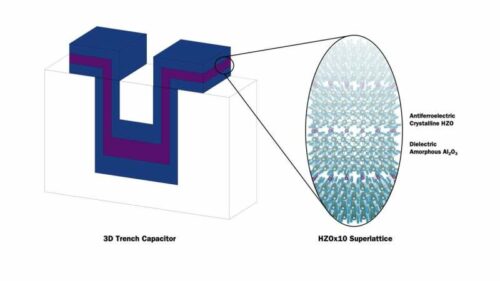Researchers at Lawrence Berkeley National Laboratory and UC Berkeley have achieved new highs in energy and power densities for microcapacitors.

The size and efficiency of electronic devices are being enhanced by integrating energy storage directly onto microchips. This strategy reduces energy loss during power transfer between components. However, for success, on-chip storage must hold substantial energy in a small space and release it quickly, challenges not yet met by existing technologies.
Tackling this issue, researchers at Lawrence Berkeley National Laboratory (Berkeley Lab) and UC Berkeley have set new records for energy and power densities in microcapacitors. They used engineered thin films of hafnium oxide and zirconium oxide, employing materials and fabrication methods that are already common in chip manufacturing.
In their research, scientists engineered thin films of HfO2-ZrO2 to achieve a negative capacitance effect, enhancing microcapacitor performance. Normally, stacking dielectric materials reduces capacitance, but these films increase it when layers exhibit negative capacitance. Produced via atomic layer deposition, these crystalline films can show ferroelectric properties with inherent polarization or antiferroelectric properties that polarize when an electric field is applied. The ratio of HfO2 to ZrO2 in the films determines these behaviors.
By finely tuning the composition, researchers positioned the films at the boundary between ferroelectric and antiferroelectric states upon charging, creating an unstable state that induces negative capacitance, allowing easy polarization with minimal electric fields. To increase energy storage capacity, the team thickened the films while maintaining this instability by inserting thin layers of aluminum oxide between the HfO2-ZrO2 layers, producing films up to 100 nm thick that still exhibited the desired properties.
In collaboration with MIT Lincoln Laboratory, researchers embedded their films into three-dimensional microcapacitor structures grown within deep silicon trenches with high aspect ratios. This design, similar to DRAM capacitors, offers higher capacitance per area, enabling more compact device integration. These advanced microcapacitors could significantly enhance energy storage in microdevices such as IoT sensors, edge computing systems, and AI processors. The team is now focused on scaling this technology for full-sized microchips and improving the films’ negative capacitance properties to boost performance further.
Reference: Suraj S. Cheema et al, Giant energy storage and power density negative capacitance superlattices, Nature (2024). DOI: 10.1038/s41586-024-07365-5







